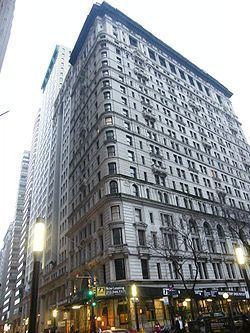Built 1895-98 Designated NRHP August 28, 1998 Height 97 m Floors 22 Architecture firm Kimball & Thompson | NRHP Reference # 83004643 Designated NYCL June 25, 1996 Opened 1898 Architectural style Neoclassical architecture | |
 | ||
Similar Adams Express Building, Manhattan Life Insurance, American Surety Building, Equitable Building, 65 Broadway | ||
The Empire Building at 71 Broadway on the corner of Rector Street in the Financial District of Manhattan, New York City is a 21-story (69.3 m) steel framed curtain-wall skyscraper designed by Kimball & Thompson in the Classical Revival style and built by Marc Eidlitz & Son from 1895-98. It is one of the earliest skyscrapers built on pneumatic caissons and one of the oldest still standing today. The building was the home of United States Steel Corporation from its founding in 1901 to 1976. Since 1997, it has served as an apartment building. It was designated a New York City landmark in 1996 and placed on the National Register of Historic Places in 1998.
Contents
History
In 1884, Orlando B. Potter purchased a six-story 1859 brownstone office building at 71 Broadway. It was the site of an assassination attempt on Russell Sage in 1891. After Potter died suddenly in 1894, his estate, managed by his children, commissioned the current building.
On April 23, 1919, the United States Steel Corporation, a major tenant since its formation in 1901, bought the building from the Potter trust for approximately US$5 million in cash. It was their world headquarters until 1976, even after they sold the building in 1973. They remained in the building until the mid-1980s.
The Empire Building was converted to 237 apartments in 1997 by World-Wide Group of Manhattan who had purchased the foreclosed property for approximately US$10 million.
Architecture
Site
The plot measures 78 feet (24 m) along Broadway, 223 feet (68 m) along Rector Street, and 50 feet (15 m) on Trinity Place with a footprint of approximately 14,000 square feet (1,300 m2) and a total floorspace of 300,000 square feet (28,000 m2). Some portions of the Broadway entrance cross over the lot line. Along Rector Street it is adjacent to the churchyard of Trinity Church, providing a dramatic backdrop for the church and ensuring open views for the building.
Foundation
Charles Sooysmith designed the foundation which was a mix of grillage and 23 pneumatic concrete caissons which went 23 feet (7.0 m) down to bedrock.
Design
The building has a tripartite design with a base, shaft, and capital sections, as in the column of a classical order. The original design called for architectural terracotta sheathing, but the owners switched to granite. The base is four stories of polished gray granite. The shaft is twelve stories of a white rusticated granite. The capital is four stories tall with colonnaded loggias and a metal cornice. There is a full basement which is exposed along Rector Street and a full-height storefront on Trinity Place due to the difference in elevation between the front and the back of the building.
The main entrance on Broadway is based on a triumphal arch with a main archway and two smaller flanking ones which leads to first floor stores.
Additions
The twenty-first floor designed by John C. Westervelt was added in 1930. The main entrance on Broadway, the Trinity Place entrance, and the connection to the elevated train on Trinity Place were all refashioned in an Art Deco style by Walker & Gillette in 1938.
